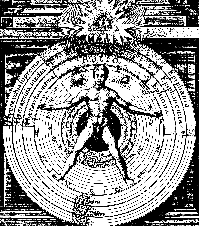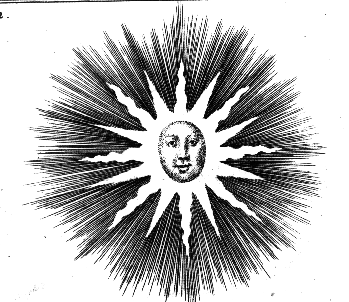Birthday Suits

by Fr. Johann Jakob Bægert (1771)
May 20, 1769
"When the Spanish padres came through," I tell my friends, "their first thought was to build a mission." The Indians were perfectly content to go around eating their piñoles and sweet cactus and mescal, dressed up in their birthday suits, but the Spaniards wanted to have some symbol of their proper religion --- they wanted to clothe the land (and the Indians) --- so they caused thirty missions to be built thoughout the 800 miles of Baja California. They, like the city planners of the urban United States, had a definite (and intractable) edifice complex. The missions were all the same: imposing, cool, with tall ceilings --- always relief from the blasting heat outside --- but always with the feeling of prison, with twelve-foot heavy doors, the black metal bars and hinges.
In the midst of the bone-desert lava-flow lies the oasis of San Ignacio, the clear and lovely lake at dusk, surrounded by tule and palm trees. The mission, dating from 1786, is exquisitely designed, decorated with several irregular points atop the structure --- a half-dozen giant strawberries, and a dozen or so round windows here and there, surrounded by faded red rings and diamond-shaped workings. There is the usual huge, wooden door, with elaborate black-metal hinges. It's dark and cool inside.
The next day, as we drive west and north of San Ignacio, I catch myself thinking about Padre Junipero Serra. We're going along the same trail he took, although at a slightly different speed. The good father marched north from Loreto --- a hundred miles below Mulegé --- between March 28 and July 1, 1769. He and his followers went by foot across some of the most parched, dry, inhospitable, burning hills, arroyos, and mountains in the world.
But to read his words, one would never think that he was trudging along through a wasteland, with his soldiers, a few burros and Indians, and the newly appointed Governor Portola. In fact, reading his entries, one would think we were on the road to Paradise. Which --- romantic that he was --- perhaps was true.
At San Andres he wrote:
- What we saw was a vast extent of good land, all prairies and well watered. It is an excellent site for another good mission and ranchería.
On May 16th, he paused at
- a pleasant spot called San Juan de Dios. We found here plenty of water, pasture, alders, tules and a bright sky.
And on June 13:
- The explorers sent us word about 3:00 P.M. that we may take our choice of two good watering places. The first is three leagues from here; the second is five. Both have plenty of sweet water, with abundant pasture for the stock. God be praised!
Even at those places where there was absolutely no water, he could find something of interest, such as on June 2, when he reported the discovery of "Rose Canyon:"I have noted the beauty and abundance of flowers. To indicate the truth of this, when we arrived at our camp site today we found here the Queen of the All --- the Rose of Castile. As I write I have before me, a stem on which there are three full blossoms, several buds, and more than six whose petals have fallen.
Was he as deranged as Columbus --- to whom he bears no little spiritual resemblance? Or was he just an optimistic talespinner? Maybe the father had a necessary supply of bunkum
in his soul, something appropriate to other salesmen that were to appear in Alta California a hundred years later. It may have had to do with the fact that if he were to report honestly on the barrenness of the countryside, it would be the end of any and all further exploration or interest from the Spanish Crown. By sending back glowing reports of verdant fields and potable water --- even hinting at a good silver mine just waiting to be worked --- Serra was making sure that his own stupendous efforts on this godforsaken peninsula would not be in vain. Perhaps it is wrong to call him a liar. Perhaps it is best to think of him as a romantic, the Don Quixote of the desert, a man who was able to find flowers and trees and good, sweet water where no one before (or since) ever has been able to do so. There has to be something daft, indeed, about one who presumes to walk eight-hundred miles up one of the most barren peninsulas in the world, claiming all the while that it is in the service of The Divine ("I have undertaken this journey to the Ports and San Diego and Monterey, for the greater glory of God and the conversion of heathen to our Holy Catholic Faith," he wrote). Serra's tale is not only one of romantic tale telling. It has the feel, as well, of tragedy to come. Not for the Spaniards, certainly --- they had the cross and the musket to protect them. It was the ruinous, events that would soon enough befall the Indians, the happy "Gentiles" that the Spaniards met. For them, the crossing of paths was as much as if they had met Mr. Death himself. Instead of the crucifix, it would, perhaps, have been more appropriate for Serra to carry a Death's Head on his breast. For he, the soldiers, the priests, and the Spaniards who followed over the next decades were to leave behind them virulent diseases --- mostly syphilis -- that killed off 50,000 Indians and laid waste to a whole innocent culture. In less than a century, the Indians who roamed Baja California would be reduced to 2,000 in number by a corruption of flesh presented, gratis, by Padre Serra and his followers. This is a priest's report from a mere fifteen years later:
A special gift of the soldiery, the camp followers, and the religionists of Spain. For that reason, Serra's descriptions of the "Gentiles" is especially piquant --- for it was the last time that they would be so free and alive, so free of the European sicknesses. Their innocence has the hue of tragedy because they were so eager to contact these strangers, showing them their naïve way with possessions.
Excellent conceit: wanting "all the clothes that he wore." We'd be the last to think of Serra as obsessed, but he mentions a dozen times that the Indians were as naked as on the day of their birth:
Lo! the poor Indian. And denizens from Civilization came to them, and would clothe them, and tell them right from wrong. And there would be nothing to fear:
Fall into the apostolic net. The naked Heathen. Now saved by the Holy Church. Beasts now saved by the bald man with the piercing eyes and the heavy cloak. "The Father would be their best friend." "There was nothing to fear." Nothing to fear.
They are fat and big now, big enough so that the Spaniards think of turning them into soldiers, an Army of the Cross. Lo, the poor Indian! So happy and fun-loving, so curious about these interesting people from another land, men with their burros (how the Indians loved playing with them) and these funny shaped coarse materials they called "clothes." Lo, the poor Indian, who, in such a short period of time, would be devastated by the sicknesses that ran through the hearts of the holy Spaniards. It was only a century-and-a-half later that Arthur North was to write:
Those Indians who did not die, who became part of the missions --- the few who were not murdered by the social diseases out of Civilization --- would be treated so wretchedly with scourge and rod meted out by the Spaniards that one commentor opined that the Indians would most certainly be better off dead rather than saved. I do for them what I can, caress them as I may --- And thus we journey onward. That sweet infant with such a short time to live.
The missions of San José, Santiago, Todos Santos, San Javier, Loreto, San José de Comondú, Purisima, Concepción, and Santa Rosalia de Mulegé are on the way to total extinction. The reason is so evident that it leaves no doubt. Syphilis has taken possession of both sexes to such a degree that mothers do not conceive, and if they do conceive, the fetus is born with little hope of living. There are three times as many adults who die as there are babies born.
So many came that I could not count them. But their amiability soon degenerated into familiarity. If, in token of friendship, one placed his hands on their heads or shoulders, they would immediately repeat the gesture upon us. lf they saw us seated, they would sit right down beside us. They showed an acute desire for anything they saw or fancied --- not stopping at petty things at all. They begged me for my habit. They asked the Governor for his leather jacket, his waistcoat, his pants, and in fact, all the clothes that he wore!
I found myself face to face with a dozen of them, all grown men except two boys, about ten and fifteen. One fact impressed me, a fact which I could not believe when I read or heard it: --- they went about stark naked just like Adam in Paradise before the Sin. Thus they came among us. We mingled with them a while. But although they saw us completely dressed there was no evidence that there was the least blush of shame among them for their nakedness.
I made them understand that henceforth a Padre would be stationed here, pointing him out to them and calling him Father Miguel. They and their friends should come to visit him. They should tell their friends that there was nothing to fear, for the Father would be their best friend. The soldiers who remained with the Padre would not harm them, but would do good things for them. They must not take any cattle which roamed over the open country. They should come to the Father in case of necessity, and he would do whatever he could for them. These and other things we told them, and they listened attentively, seeming to understand. Thus it appears to me that they are ready to fall into the apostolic net...
They do not need food --- for they are big and fat! Because of their great stature, the Governor thinks they would become fine grenadiers....
The end of the Baja California lndians is near at hand. The Pericues and the Guaycuras are now practically extinct. Of the former thousands of Cochimis, perhaps a hundred still survive. Of the northern Indians there survive today remnants of the Cocopa, Catarina, Yuma, Kiliwa, Pais and Diegueno tribes, but only the first names can muster more than a hundred individuals.

A mother with a nursing infant took a notion to let me hold her baby in my arms for awhile. And thus as I held it I could scarcely resist the desire to baptise it before giving it back to its supper ... I gave them all the Sign of the Cross, and I taught them to say "Jesus! Mary!"
C. A. Amantea